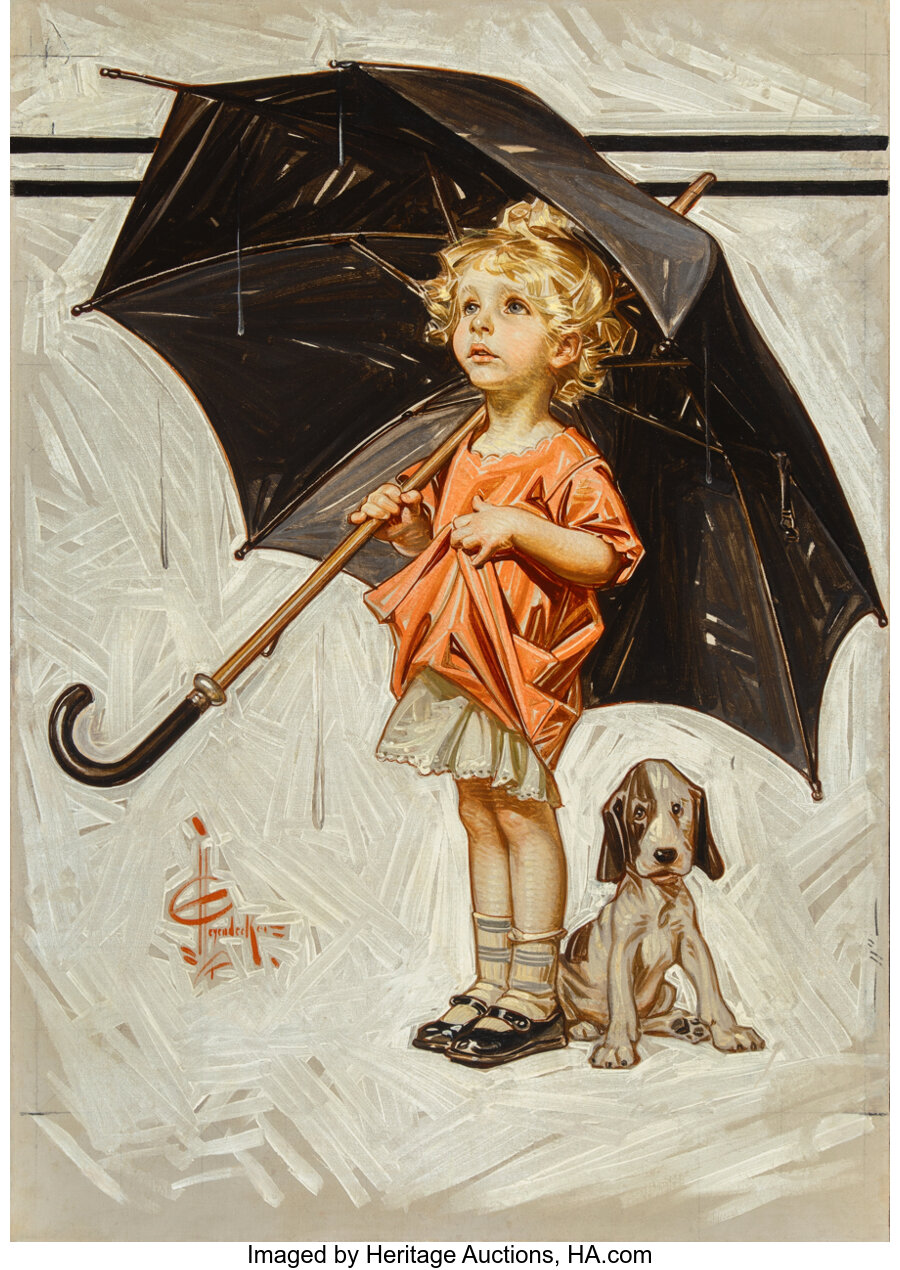Signed lower left: JC Leyendecker
Private collection, Scottsdale, Arizona.
Joseph Christian Leyendecker (American, 1874-1951) Caught in the Rain, The Saturday Evening Post cover, April 25, 1914 Oil on canvas 30 x 21 inches (76.2 x 53.3 cm) Signed lower left: JC Leyendecker PROVENANCE: Private collection, Scottsdale, Arizona. LITERATURE: M. Schau, J.C. Leyendecker, New York, 1974, p. 179, illustrated; L.S. Cutler, J.G. Cutler, J.C. Leyendecker, American Imagist, New York, 2008, p. 118, cover, illustrated. "J.C. Leyendecker uniquely captured the essence of American childhood in his illustrations, infusing each image with a mixture of innocence and sophistication. His portrayals of children are not only striking in their aesthetic appeal but also in their ability to convey the nuanced emotion and timeless elegance of youth." - P.J. Broder, The American Illustrators: The Twentieth Century, 1999, p. 142. "The imagery of children clutching umbrellas has become a poignant symbol in popular culture, representing both vulnerability and resilience. These depictions often contrast the smallness of the child against the backdrop of the larger world, encapsulated perfectly through the lens of the protective, yet fragile, umbrella." - E. Guffey, "Rainy Days, Children, Umbrellas, and the Aesthetics of Innocence," Journal of Visual Culture, 2008, p. 204. The motif of a child shielded by an umbrella against the rain has become an enduring symbol within the arts, one that continues to capture the hearts of audiences across various media. This emblematic scene captures a solitary moment of reflection amidst the chaotic symphony of life, inviting viewers into a world where innocence confronts the elements. Artists through the ages have adapted this powerful image to explore themes of vulnerability and resilience, casting the child as both a witness and a participant in the narrative of the human condition. From Banksy's poignant urban commentaries to Gil Elvgren's evocative, charming Americana (fig. 1), the playful satire of MAD Magazine (fig. 2), and even the Morton Salt Girl (fig. 3), the figure of a young person in the rain is a canvas unto itself, mirroring the whimsical, the risky, and the transcendent moments of life. At the vanguard of this artistic lineage stands J.C. Leyendecker's seminal Caught in the Rain, a 1914 cover for The Saturday Evening Post. Leyendecker's portrayal is not only a masterpiece of illustration but also serves as a pivotal inspiration for future generations of artists. His elegant composition and emotive brushwork laid the foundation for what would become an iconic tableau in visual culture. Leyendecker's interpretation of this theme weaves through the tapestry of art history, influencing the likes of Banksy, Elvgren, and others, and solidifying the image of a child with an umbrella amidst the rain as a poignant artistic device that speaks to the enduring human spirit. Art historian and The Saturday Evening Post contributor Joseph Scales has written extensively on the beauty, genius, and importance of the present work: "J.C. Leyendecker's illustrations of infants and toddlers are renowned both for ringing in the New Year and as cherubic annunciations of calendar holidays. His April 25th, 1914 cover, Caught in the Rain, takes a unique perspective on an unappreciated time of the year. This illustration celebrates the pseudo-holiday of seasonal change itself, from the dead of Christmas winter to the blossoming rebirth of Easter spring. "The artistic composition is simple, recycling the same white, canvassed background of so many other Leyendecker covers. Negative white space contrasts the cover's dark font and the black umbrella. The girl's black and white socks and shoes, along with the synonymous fur pattern of the loyal pup by her feet, replicate the cover's lighting contrast. "The black-white color scheme is important to the overall composition of the work and to the story told in illustration. Black and white dogs are actually the most common canines in all of western art history. They are the symbols of Dominican Friars who wear black and white robes. The founder of their order, St. Dominic, found his way into the clergy after witnessing a harsh Spanish famine due to lack of rain. From as far back as the medieval era, the black and white dog has represented fidelity to God in images of Dominican saints and martyrs staring up at the heavens. The dog is an old Dominican biblical pun of Dominicanus, combining the Latin name of their Dominican order and "Domini-Canes," or their nickname, "God's dogs," in Latin. "This issue, published the week after Easter, holds an important message about the power of spring, rebirth, and blossoming from the dead of winter. The innocence of the cherub-like child standing with her pup, looking to the sky and pondering the life-giving rains of spring, could easily awake heavenly questions. "The toddler stands out in her red dress. Her pale skin, rosy cheeks, and pure white undergarments barely distinguishable from the background embellish her childhood innocence. The umbrella too big, the girl too small, our infant merely wears the umbrella on her shoulder rather than hold it firmly by the Christian symbol of the shepherd's crook handle. "Without the artist's inclusion of rain, we viewers would be left out in the cold, out of seasonal context. Rather than illustrate rain in the work's white, negative space, Leyendecker purposefully depicts droplets running off the umbrella's edge. The glassy teardrops fall in front of the black backdrop of fabric, illuminating the objects that so transfix the eyes of a child. "The image in its entirety is bold, so bold that it's allowed to partially cover the staple text indicating the Post's lineage, leaving only "enj. Franklin" to express our publication's pre-American foundations. A simple message permeates this cover; while we may dread the drench of April showers, and shield ourselves from the deluge, we ought to take a moment to appreciate the season's arrival. Each spring in a new year is a singular experience for celebration, complete with new life, a new holiday, and new moments for reflection." ("Beyond the Canvas: April Showers by J.C. Leyendecker," The Saturday Evening Post, April 17, 2014, www.thesaturdayeveningpost.com) HID12401132022 © 2024 Heritage Auctions | All Rights Reserved
This painting is in good condition. It is on its original stretcher. The painting has a Beva lining with a Mylar interleaf and a Belgian linen backing. Inpaint in present corresponding to scattered small losses,
minor stains and abrasions.
A copy of the condition report from Chelsea Restoration Associates is available upon request.
Framed Dimensions 35.5 X 26.5 Inches


